Literary Criticism and Reading Practices
VerifiedAdded on 2023/06/03
|9
|2985
|386
AI Summary
This essay discusses the various reading practices like author, text, reader and world centered approaches of reading and suggests the best one that the readers can use to enhance their understanding of the contemporary literary texts. It also highlights the importance of close reading approach in understanding the literary works.
Contribute Materials
Your contribution can guide someone’s learning journey. Share your
documents today.

LITERARY CRITICISM AND READING
PRACTICES 1
Literature and the various literary works associated with it had served as a source of
delight and also entertainment for the readers since the traditional times (Richards 54).
Turner, Abrahams and Harris are of the viewpoint that the various authors use different
literary elements and also techniques to not only create an aura of verisimilitude but also
enhance the reading pleasure of the readers as well. As opined by Barry, the literary
techniques which are used by the authors to enhance the “pleasure of the text” often become
too incomprehensible for the readers and also they find it too difficult to understand the
meaning of the text in the manner in which the author wants them to. It is precisely here that
the notion of literary criticism becomes important since it enables the readers to understand
the meaning that the authors are trying to convey through their work in a much effective
manner (Long and Richard 251). More importantly, the cannon of literary criticism, is not
only redolent with various theories in which the readers can decipher the meaning of a text in
an effective manner but also offers various kinds of reading practices (McConn 70). Babcock
is of the viewpoint that the technique of reading practice is an important one since it not only
offers the opportunity to readers to read a particular literary text in the best manner but
enables the readers to draw the necessary correlations as well. This essay will discuss the
various reading practices like author, text, reader and world centered approaches of reading
and will suggest the best one that the readers can use to enhance their understanding of the
contemporary literary texts.
Goodman has stated that the notion of literary criticism can be defined as the process
of studying, evaluating as well as interpretation of a particular literary text. Furthermore, in
the recent times, it is seen that the genre of literary criticism is being influenced by the
various literary theories and also the goals or the objectives with which an author undertakes
the writing of a text (McConn 70). More importantly, the cannon of literary criticism also
PRACTICES 1
Literature and the various literary works associated with it had served as a source of
delight and also entertainment for the readers since the traditional times (Richards 54).
Turner, Abrahams and Harris are of the viewpoint that the various authors use different
literary elements and also techniques to not only create an aura of verisimilitude but also
enhance the reading pleasure of the readers as well. As opined by Barry, the literary
techniques which are used by the authors to enhance the “pleasure of the text” often become
too incomprehensible for the readers and also they find it too difficult to understand the
meaning of the text in the manner in which the author wants them to. It is precisely here that
the notion of literary criticism becomes important since it enables the readers to understand
the meaning that the authors are trying to convey through their work in a much effective
manner (Long and Richard 251). More importantly, the cannon of literary criticism, is not
only redolent with various theories in which the readers can decipher the meaning of a text in
an effective manner but also offers various kinds of reading practices (McConn 70). Babcock
is of the viewpoint that the technique of reading practice is an important one since it not only
offers the opportunity to readers to read a particular literary text in the best manner but
enables the readers to draw the necessary correlations as well. This essay will discuss the
various reading practices like author, text, reader and world centered approaches of reading
and will suggest the best one that the readers can use to enhance their understanding of the
contemporary literary texts.
Goodman has stated that the notion of literary criticism can be defined as the process
of studying, evaluating as well as interpretation of a particular literary text. Furthermore, in
the recent times, it is seen that the genre of literary criticism is being influenced by the
various literary theories and also the goals or the objectives with which an author undertakes
the writing of a text (McConn 70). More importantly, the cannon of literary criticism also
Secure Best Marks with AI Grader
Need help grading? Try our AI Grader for instant feedback on your assignments.
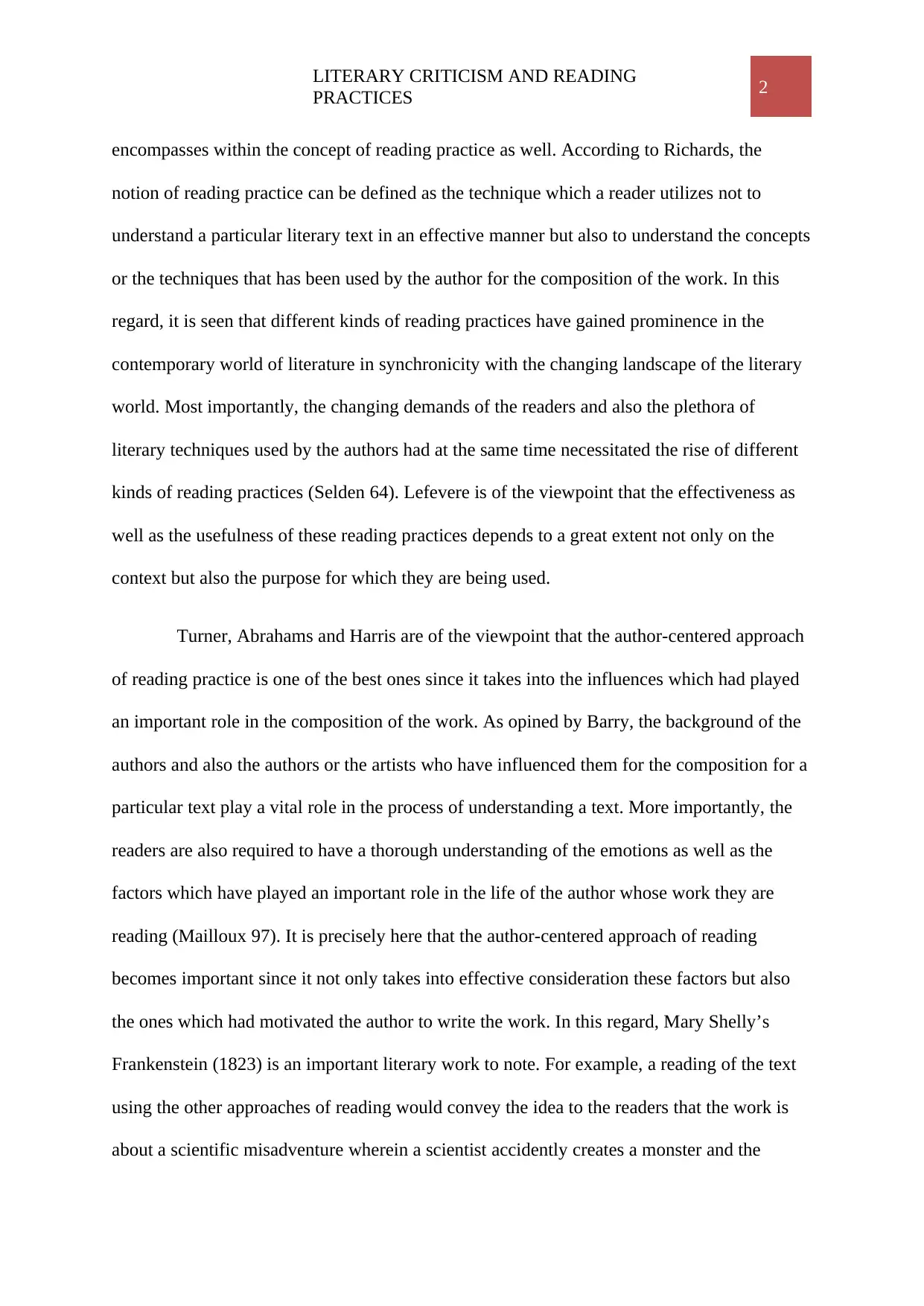
LITERARY CRITICISM AND READING
PRACTICES 2
encompasses within the concept of reading practice as well. According to Richards, the
notion of reading practice can be defined as the technique which a reader utilizes not to
understand a particular literary text in an effective manner but also to understand the concepts
or the techniques that has been used by the author for the composition of the work. In this
regard, it is seen that different kinds of reading practices have gained prominence in the
contemporary world of literature in synchronicity with the changing landscape of the literary
world. Most importantly, the changing demands of the readers and also the plethora of
literary techniques used by the authors had at the same time necessitated the rise of different
kinds of reading practices (Selden 64). Lefevere is of the viewpoint that the effectiveness as
well as the usefulness of these reading practices depends to a great extent not only on the
context but also the purpose for which they are being used.
Turner, Abrahams and Harris are of the viewpoint that the author-centered approach
of reading practice is one of the best ones since it takes into the influences which had played
an important role in the composition of the work. As opined by Barry, the background of the
authors and also the authors or the artists who have influenced them for the composition for a
particular text play a vital role in the process of understanding a text. More importantly, the
readers are also required to have a thorough understanding of the emotions as well as the
factors which have played an important role in the life of the author whose work they are
reading (Mailloux 97). It is precisely here that the author-centered approach of reading
becomes important since it not only takes into effective consideration these factors but also
the ones which had motivated the author to write the work. In this regard, Mary Shelly’s
Frankenstein (1823) is an important literary work to note. For example, a reading of the text
using the other approaches of reading would convey the idea to the readers that the work is
about a scientific misadventure wherein a scientist accidently creates a monster and the
PRACTICES 2
encompasses within the concept of reading practice as well. According to Richards, the
notion of reading practice can be defined as the technique which a reader utilizes not to
understand a particular literary text in an effective manner but also to understand the concepts
or the techniques that has been used by the author for the composition of the work. In this
regard, it is seen that different kinds of reading practices have gained prominence in the
contemporary world of literature in synchronicity with the changing landscape of the literary
world. Most importantly, the changing demands of the readers and also the plethora of
literary techniques used by the authors had at the same time necessitated the rise of different
kinds of reading practices (Selden 64). Lefevere is of the viewpoint that the effectiveness as
well as the usefulness of these reading practices depends to a great extent not only on the
context but also the purpose for which they are being used.
Turner, Abrahams and Harris are of the viewpoint that the author-centered approach
of reading practice is one of the best ones since it takes into the influences which had played
an important role in the composition of the work. As opined by Barry, the background of the
authors and also the authors or the artists who have influenced them for the composition for a
particular text play a vital role in the process of understanding a text. More importantly, the
readers are also required to have a thorough understanding of the emotions as well as the
factors which have played an important role in the life of the author whose work they are
reading (Mailloux 97). It is precisely here that the author-centered approach of reading
becomes important since it not only takes into effective consideration these factors but also
the ones which had motivated the author to write the work. In this regard, Mary Shelly’s
Frankenstein (1823) is an important literary work to note. For example, a reading of the text
using the other approaches of reading would convey the idea to the readers that the work is
about a scientific misadventure wherein a scientist accidently creates a monster and the
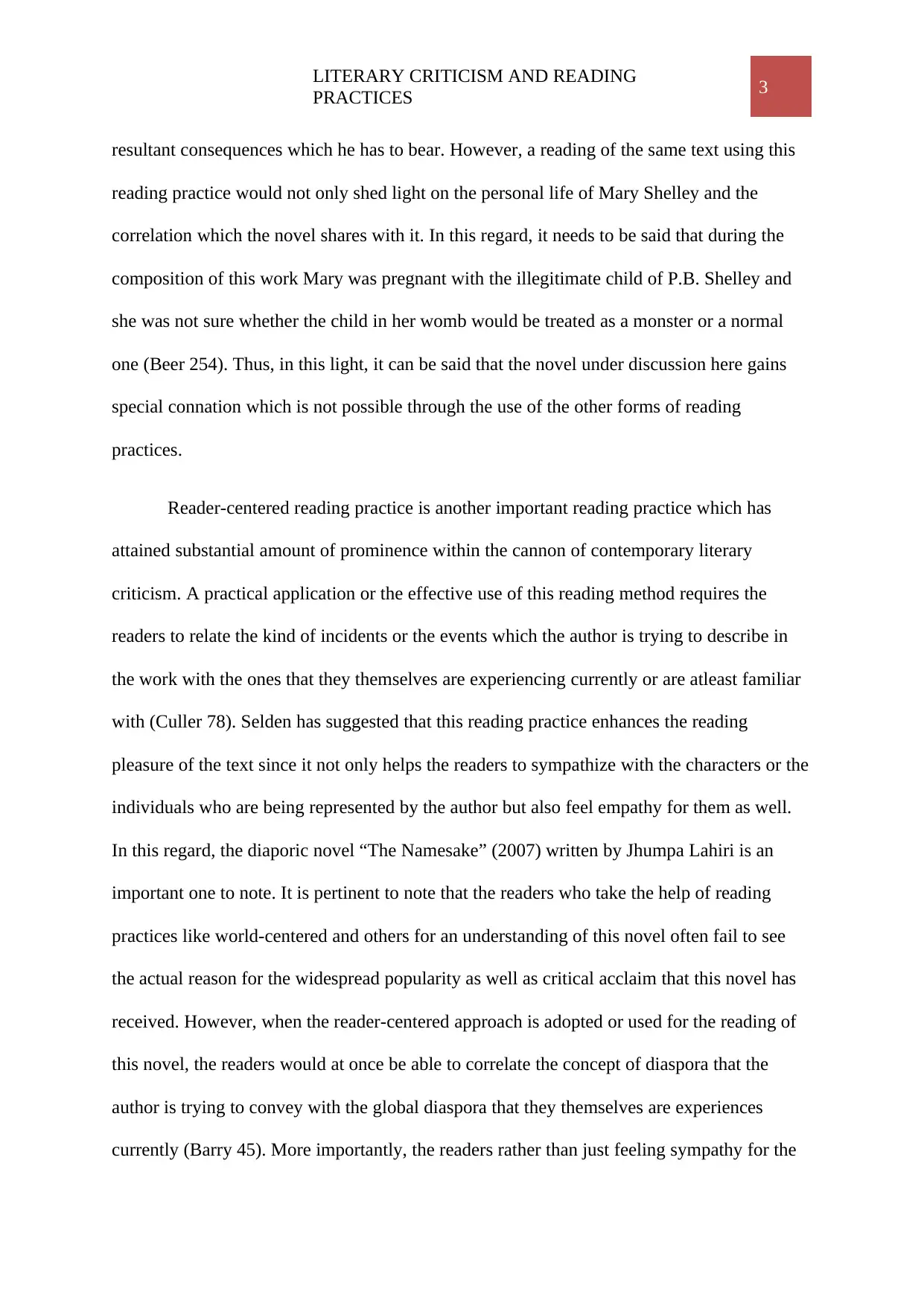
LITERARY CRITICISM AND READING
PRACTICES 3
resultant consequences which he has to bear. However, a reading of the same text using this
reading practice would not only shed light on the personal life of Mary Shelley and the
correlation which the novel shares with it. In this regard, it needs to be said that during the
composition of this work Mary was pregnant with the illegitimate child of P.B. Shelley and
she was not sure whether the child in her womb would be treated as a monster or a normal
one (Beer 254). Thus, in this light, it can be said that the novel under discussion here gains
special connation which is not possible through the use of the other forms of reading
practices.
Reader-centered reading practice is another important reading practice which has
attained substantial amount of prominence within the cannon of contemporary literary
criticism. A practical application or the effective use of this reading method requires the
readers to relate the kind of incidents or the events which the author is trying to describe in
the work with the ones that they themselves are experiencing currently or are atleast familiar
with (Culler 78). Selden has suggested that this reading practice enhances the reading
pleasure of the text since it not only helps the readers to sympathize with the characters or the
individuals who are being represented by the author but also feel empathy for them as well.
In this regard, the diaporic novel “The Namesake” (2007) written by Jhumpa Lahiri is an
important one to note. It is pertinent to note that the readers who take the help of reading
practices like world-centered and others for an understanding of this novel often fail to see
the actual reason for the widespread popularity as well as critical acclaim that this novel has
received. However, when the reader-centered approach is adopted or used for the reading of
this novel, the readers would at once be able to correlate the concept of diaspora that the
author is trying to convey with the global diaspora that they themselves are experiences
currently (Barry 45). More importantly, the readers rather than just feeling sympathy for the
PRACTICES 3
resultant consequences which he has to bear. However, a reading of the same text using this
reading practice would not only shed light on the personal life of Mary Shelley and the
correlation which the novel shares with it. In this regard, it needs to be said that during the
composition of this work Mary was pregnant with the illegitimate child of P.B. Shelley and
she was not sure whether the child in her womb would be treated as a monster or a normal
one (Beer 254). Thus, in this light, it can be said that the novel under discussion here gains
special connation which is not possible through the use of the other forms of reading
practices.
Reader-centered reading practice is another important reading practice which has
attained substantial amount of prominence within the cannon of contemporary literary
criticism. A practical application or the effective use of this reading method requires the
readers to relate the kind of incidents or the events which the author is trying to describe in
the work with the ones that they themselves are experiencing currently or are atleast familiar
with (Culler 78). Selden has suggested that this reading practice enhances the reading
pleasure of the text since it not only helps the readers to sympathize with the characters or the
individuals who are being represented by the author but also feel empathy for them as well.
In this regard, the diaporic novel “The Namesake” (2007) written by Jhumpa Lahiri is an
important one to note. It is pertinent to note that the readers who take the help of reading
practices like world-centered and others for an understanding of this novel often fail to see
the actual reason for the widespread popularity as well as critical acclaim that this novel has
received. However, when the reader-centered approach is adopted or used for the reading of
this novel, the readers would at once be able to correlate the concept of diaspora that the
author is trying to convey with the global diaspora that they themselves are experiences
currently (Barry 45). More importantly, the readers rather than just feeling sympathy for the
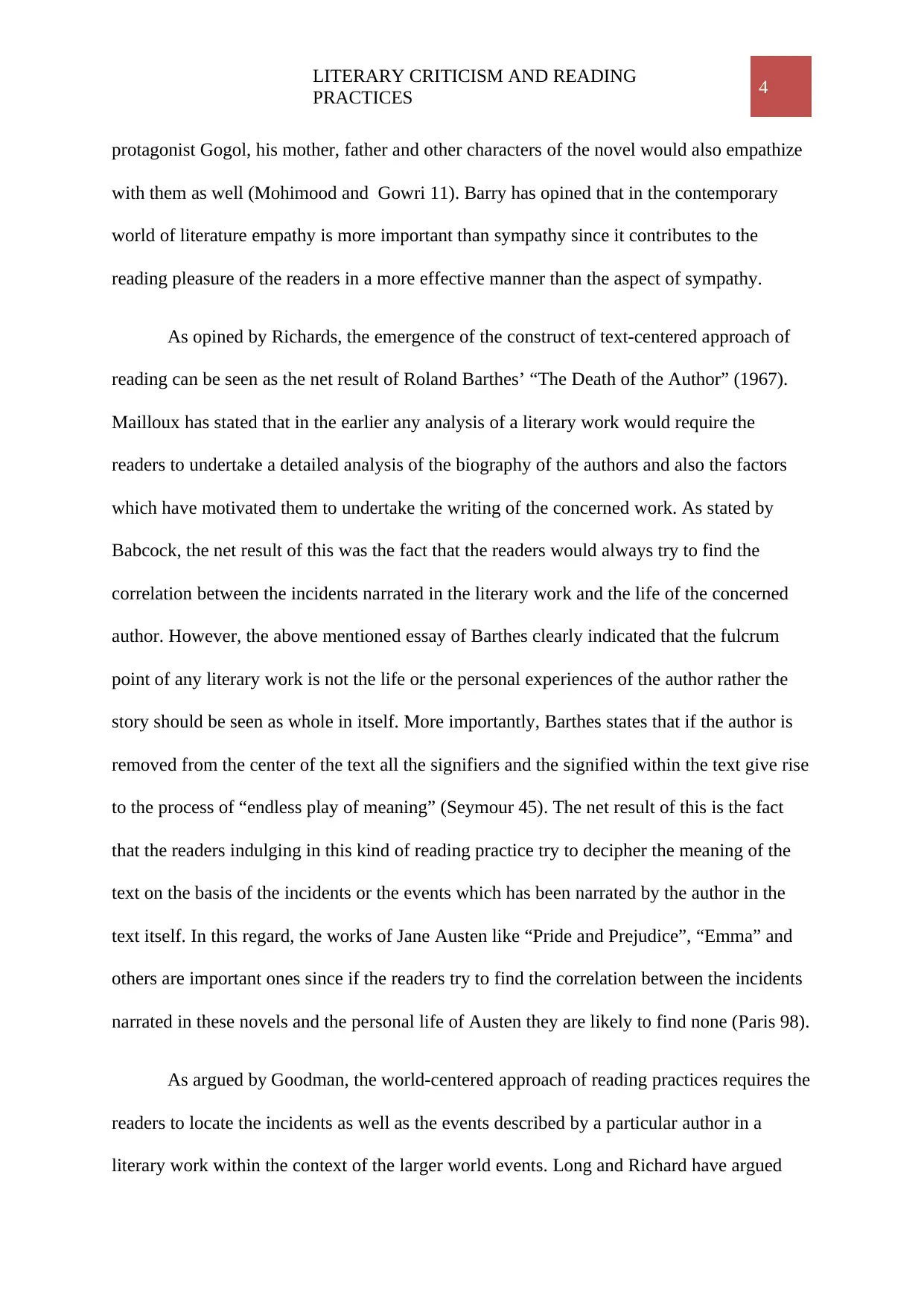
LITERARY CRITICISM AND READING
PRACTICES 4
protagonist Gogol, his mother, father and other characters of the novel would also empathize
with them as well (Mohimood and Gowri 11). Barry has opined that in the contemporary
world of literature empathy is more important than sympathy since it contributes to the
reading pleasure of the readers in a more effective manner than the aspect of sympathy.
As opined by Richards, the emergence of the construct of text-centered approach of
reading can be seen as the net result of Roland Barthes’ “The Death of the Author” (1967).
Mailloux has stated that in the earlier any analysis of a literary work would require the
readers to undertake a detailed analysis of the biography of the authors and also the factors
which have motivated them to undertake the writing of the concerned work. As stated by
Babcock, the net result of this was the fact that the readers would always try to find the
correlation between the incidents narrated in the literary work and the life of the concerned
author. However, the above mentioned essay of Barthes clearly indicated that the fulcrum
point of any literary work is not the life or the personal experiences of the author rather the
story should be seen as whole in itself. More importantly, Barthes states that if the author is
removed from the center of the text all the signifiers and the signified within the text give rise
to the process of “endless play of meaning” (Seymour 45). The net result of this is the fact
that the readers indulging in this kind of reading practice try to decipher the meaning of the
text on the basis of the incidents or the events which has been narrated by the author in the
text itself. In this regard, the works of Jane Austen like “Pride and Prejudice”, “Emma” and
others are important ones since if the readers try to find the correlation between the incidents
narrated in these novels and the personal life of Austen they are likely to find none (Paris 98).
As argued by Goodman, the world-centered approach of reading practices requires the
readers to locate the incidents as well as the events described by a particular author in a
literary work within the context of the larger world events. Long and Richard have argued
PRACTICES 4
protagonist Gogol, his mother, father and other characters of the novel would also empathize
with them as well (Mohimood and Gowri 11). Barry has opined that in the contemporary
world of literature empathy is more important than sympathy since it contributes to the
reading pleasure of the readers in a more effective manner than the aspect of sympathy.
As opined by Richards, the emergence of the construct of text-centered approach of
reading can be seen as the net result of Roland Barthes’ “The Death of the Author” (1967).
Mailloux has stated that in the earlier any analysis of a literary work would require the
readers to undertake a detailed analysis of the biography of the authors and also the factors
which have motivated them to undertake the writing of the concerned work. As stated by
Babcock, the net result of this was the fact that the readers would always try to find the
correlation between the incidents narrated in the literary work and the life of the concerned
author. However, the above mentioned essay of Barthes clearly indicated that the fulcrum
point of any literary work is not the life or the personal experiences of the author rather the
story should be seen as whole in itself. More importantly, Barthes states that if the author is
removed from the center of the text all the signifiers and the signified within the text give rise
to the process of “endless play of meaning” (Seymour 45). The net result of this is the fact
that the readers indulging in this kind of reading practice try to decipher the meaning of the
text on the basis of the incidents or the events which has been narrated by the author in the
text itself. In this regard, the works of Jane Austen like “Pride and Prejudice”, “Emma” and
others are important ones since if the readers try to find the correlation between the incidents
narrated in these novels and the personal life of Austen they are likely to find none (Paris 98).
As argued by Goodman, the world-centered approach of reading practices requires the
readers to locate the incidents as well as the events described by a particular author in a
literary work within the context of the larger world events. Long and Richard have argued
Secure Best Marks with AI Grader
Need help grading? Try our AI Grader for instant feedback on your assignments.

LITERARY CRITICISM AND READING
PRACTICES 5
that this approach of reading practice has gained a substantial amount of prominence within
the present world of literature of the attitude of the authors to embed the different historical
events within the framework of the characters or the incidents described by them in their
work. Furthermore, this aspect gains even more popularity when the landscape of the
contemporary literature is taken into consideration wherein it is seen that the authors take the
help of this technique to enhance the meaning and also the pleasure of the text. In this regard,
the works of Katherine Mansfield like “The Fly” and others are important ones to note. For
example, a reading of the short story “The Fly” taking the help of other approaches of reading
practices would make the readers feel that the story is about the feeling of loss and
bereavement felt by a father for the death of his only son. However, a reading of the same
story taking the help of this reading practice would reveal the fact that Mansfield has
embedded various references to the Second World War in the story and as a matter of fact the
entire has been set in its backdrop (Edwards 14).
An effective use of the above mentioned reading practices no doubt offers various
benefits to the readings and as a matter of fact in the majority of the cases to an effective
understanding of the literary work. However, at the same time, it needs to be said that there
are some inherent weaknesses of the drawbacks of these approaches to reading practices as
well. For example, the author-centered approach relies too much on the background
information of the author (McConn 70). The text-centered approach by negating the
influences of the author misses out on that aspect (Goodman 120). The reader-centered
approach, on the other hand, focuses too much on the aspect of the readers and the world-
centered approach requires the readers to have an understanding of the various world events.
Turner, Abrahams and Harris are of the viewpoint that the close reading approach is perhaps
PRACTICES 5
that this approach of reading practice has gained a substantial amount of prominence within
the present world of literature of the attitude of the authors to embed the different historical
events within the framework of the characters or the incidents described by them in their
work. Furthermore, this aspect gains even more popularity when the landscape of the
contemporary literature is taken into consideration wherein it is seen that the authors take the
help of this technique to enhance the meaning and also the pleasure of the text. In this regard,
the works of Katherine Mansfield like “The Fly” and others are important ones to note. For
example, a reading of the short story “The Fly” taking the help of other approaches of reading
practices would make the readers feel that the story is about the feeling of loss and
bereavement felt by a father for the death of his only son. However, a reading of the same
story taking the help of this reading practice would reveal the fact that Mansfield has
embedded various references to the Second World War in the story and as a matter of fact the
entire has been set in its backdrop (Edwards 14).
An effective use of the above mentioned reading practices no doubt offers various
benefits to the readings and as a matter of fact in the majority of the cases to an effective
understanding of the literary work. However, at the same time, it needs to be said that there
are some inherent weaknesses of the drawbacks of these approaches to reading practices as
well. For example, the author-centered approach relies too much on the background
information of the author (McConn 70). The text-centered approach by negating the
influences of the author misses out on that aspect (Goodman 120). The reader-centered
approach, on the other hand, focuses too much on the aspect of the readers and the world-
centered approach requires the readers to have an understanding of the various world events.
Turner, Abrahams and Harris are of the viewpoint that the close reading approach is perhaps
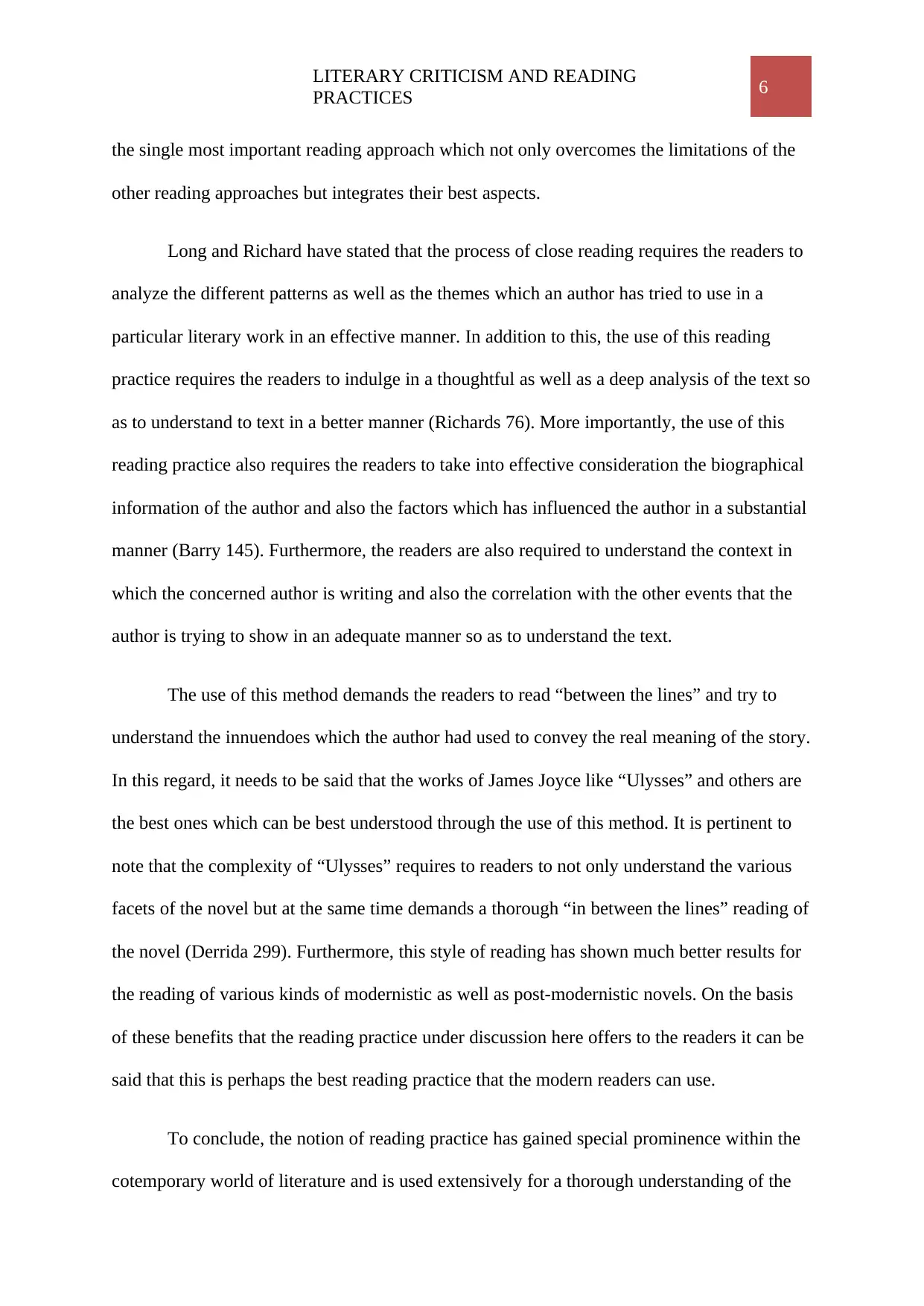
LITERARY CRITICISM AND READING
PRACTICES 6
the single most important reading approach which not only overcomes the limitations of the
other reading approaches but integrates their best aspects.
Long and Richard have stated that the process of close reading requires the readers to
analyze the different patterns as well as the themes which an author has tried to use in a
particular literary work in an effective manner. In addition to this, the use of this reading
practice requires the readers to indulge in a thoughtful as well as a deep analysis of the text so
as to understand to text in a better manner (Richards 76). More importantly, the use of this
reading practice also requires the readers to take into effective consideration the biographical
information of the author and also the factors which has influenced the author in a substantial
manner (Barry 145). Furthermore, the readers are also required to understand the context in
which the concerned author is writing and also the correlation with the other events that the
author is trying to show in an adequate manner so as to understand the text.
The use of this method demands the readers to read “between the lines” and try to
understand the innuendoes which the author had used to convey the real meaning of the story.
In this regard, it needs to be said that the works of James Joyce like “Ulysses” and others are
the best ones which can be best understood through the use of this method. It is pertinent to
note that the complexity of “Ulysses” requires to readers to not only understand the various
facets of the novel but at the same time demands a thorough “in between the lines” reading of
the novel (Derrida 299). Furthermore, this style of reading has shown much better results for
the reading of various kinds of modernistic as well as post-modernistic novels. On the basis
of these benefits that the reading practice under discussion here offers to the readers it can be
said that this is perhaps the best reading practice that the modern readers can use.
To conclude, the notion of reading practice has gained special prominence within the
cotemporary world of literature and is used extensively for a thorough understanding of the
PRACTICES 6
the single most important reading approach which not only overcomes the limitations of the
other reading approaches but integrates their best aspects.
Long and Richard have stated that the process of close reading requires the readers to
analyze the different patterns as well as the themes which an author has tried to use in a
particular literary work in an effective manner. In addition to this, the use of this reading
practice requires the readers to indulge in a thoughtful as well as a deep analysis of the text so
as to understand to text in a better manner (Richards 76). More importantly, the use of this
reading practice also requires the readers to take into effective consideration the biographical
information of the author and also the factors which has influenced the author in a substantial
manner (Barry 145). Furthermore, the readers are also required to understand the context in
which the concerned author is writing and also the correlation with the other events that the
author is trying to show in an adequate manner so as to understand the text.
The use of this method demands the readers to read “between the lines” and try to
understand the innuendoes which the author had used to convey the real meaning of the story.
In this regard, it needs to be said that the works of James Joyce like “Ulysses” and others are
the best ones which can be best understood through the use of this method. It is pertinent to
note that the complexity of “Ulysses” requires to readers to not only understand the various
facets of the novel but at the same time demands a thorough “in between the lines” reading of
the novel (Derrida 299). Furthermore, this style of reading has shown much better results for
the reading of various kinds of modernistic as well as post-modernistic novels. On the basis
of these benefits that the reading practice under discussion here offers to the readers it can be
said that this is perhaps the best reading practice that the modern readers can use.
To conclude, the notion of reading practice has gained special prominence within the
cotemporary world of literature and is used extensively for a thorough understanding of the
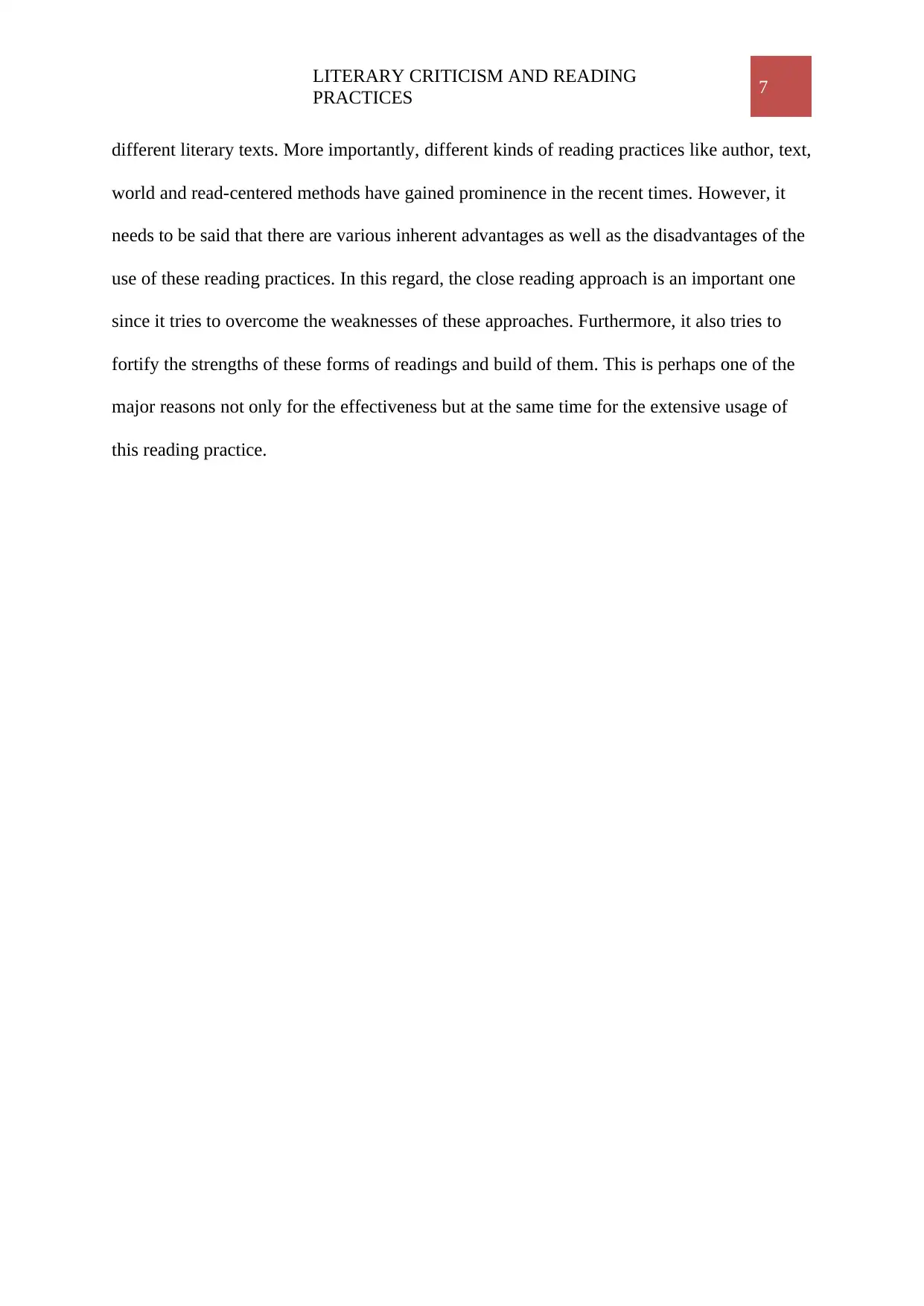
LITERARY CRITICISM AND READING
PRACTICES 7
different literary texts. More importantly, different kinds of reading practices like author, text,
world and read-centered methods have gained prominence in the recent times. However, it
needs to be said that there are various inherent advantages as well as the disadvantages of the
use of these reading practices. In this regard, the close reading approach is an important one
since it tries to overcome the weaknesses of these approaches. Furthermore, it also tries to
fortify the strengths of these forms of readings and build of them. This is perhaps one of the
major reasons not only for the effectiveness but at the same time for the extensive usage of
this reading practice.
PRACTICES 7
different literary texts. More importantly, different kinds of reading practices like author, text,
world and read-centered methods have gained prominence in the recent times. However, it
needs to be said that there are various inherent advantages as well as the disadvantages of the
use of these reading practices. In this regard, the close reading approach is an important one
since it tries to overcome the weaknesses of these approaches. Furthermore, it also tries to
fortify the strengths of these forms of readings and build of them. This is perhaps one of the
major reasons not only for the effectiveness but at the same time for the extensive usage of
this reading practice.
Paraphrase This Document
Need a fresh take? Get an instant paraphrase of this document with our AI Paraphraser
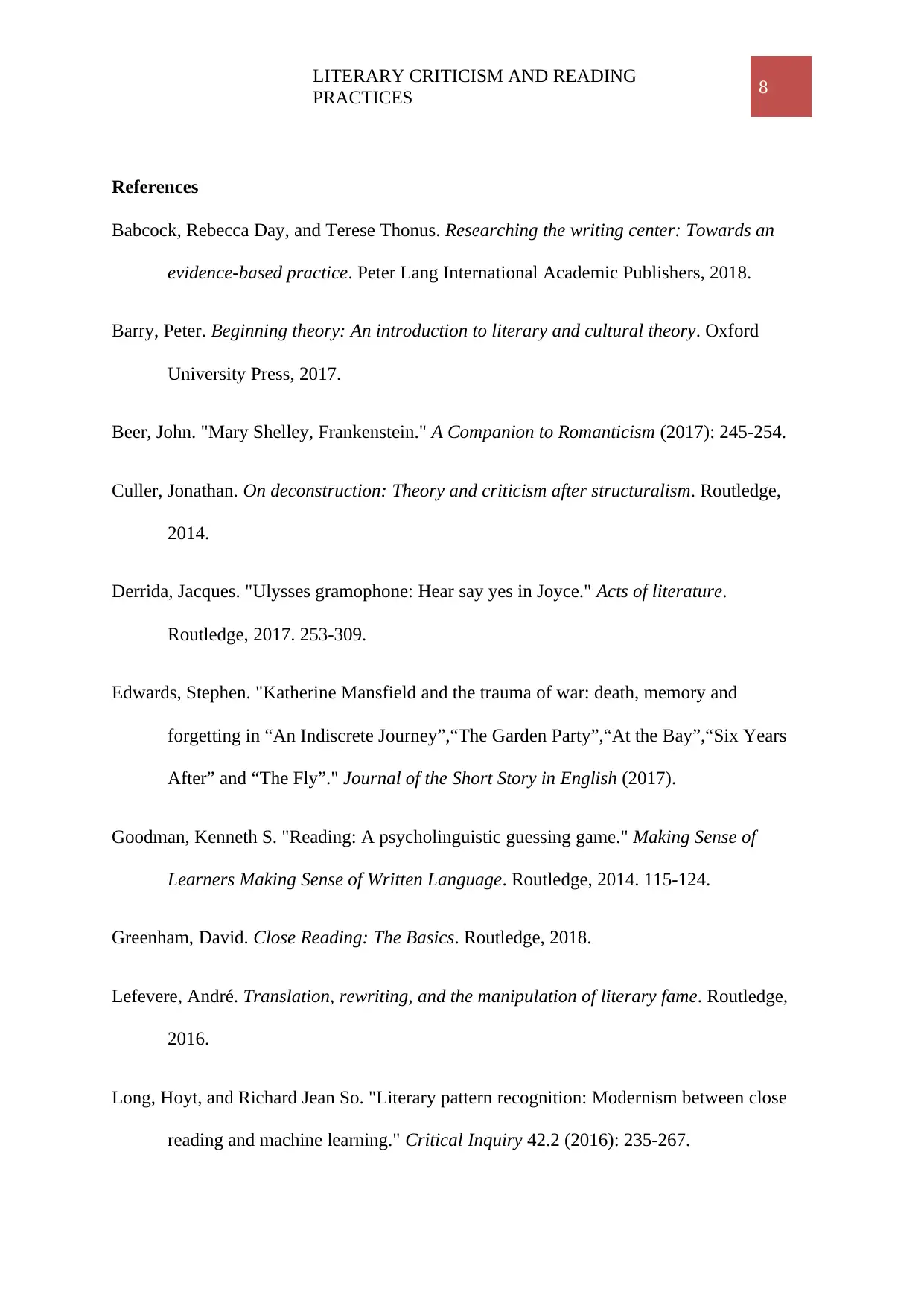
LITERARY CRITICISM AND READING
PRACTICES 8
References
Babcock, Rebecca Day, and Terese Thonus. Researching the writing center: Towards an
evidence-based practice. Peter Lang International Academic Publishers, 2018.
Barry, Peter. Beginning theory: An introduction to literary and cultural theory. Oxford
University Press, 2017.
Beer, John. "Mary Shelley, Frankenstein." A Companion to Romanticism (2017): 245-254.
Culler, Jonathan. On deconstruction: Theory and criticism after structuralism. Routledge,
2014.
Derrida, Jacques. "Ulysses gramophone: Hear say yes in Joyce." Acts of literature.
Routledge, 2017. 253-309.
Edwards, Stephen. "Katherine Mansfield and the trauma of war: death, memory and
forgetting in “An Indiscrete Journey”,“The Garden Party”,“At the Bay”,“Six Years
After” and “The Fly”." Journal of the Short Story in English (2017).
Goodman, Kenneth S. "Reading: A psycholinguistic guessing game." Making Sense of
Learners Making Sense of Written Language. Routledge, 2014. 115-124.
Greenham, David. Close Reading: The Basics. Routledge, 2018.
Lefevere, André. Translation, rewriting, and the manipulation of literary fame. Routledge,
2016.
Long, Hoyt, and Richard Jean So. "Literary pattern recognition: Modernism between close
reading and machine learning." Critical Inquiry 42.2 (2016): 235-267.
PRACTICES 8
References
Babcock, Rebecca Day, and Terese Thonus. Researching the writing center: Towards an
evidence-based practice. Peter Lang International Academic Publishers, 2018.
Barry, Peter. Beginning theory: An introduction to literary and cultural theory. Oxford
University Press, 2017.
Beer, John. "Mary Shelley, Frankenstein." A Companion to Romanticism (2017): 245-254.
Culler, Jonathan. On deconstruction: Theory and criticism after structuralism. Routledge,
2014.
Derrida, Jacques. "Ulysses gramophone: Hear say yes in Joyce." Acts of literature.
Routledge, 2017. 253-309.
Edwards, Stephen. "Katherine Mansfield and the trauma of war: death, memory and
forgetting in “An Indiscrete Journey”,“The Garden Party”,“At the Bay”,“Six Years
After” and “The Fly”." Journal of the Short Story in English (2017).
Goodman, Kenneth S. "Reading: A psycholinguistic guessing game." Making Sense of
Learners Making Sense of Written Language. Routledge, 2014. 115-124.
Greenham, David. Close Reading: The Basics. Routledge, 2018.
Lefevere, André. Translation, rewriting, and the manipulation of literary fame. Routledge,
2016.
Long, Hoyt, and Richard Jean So. "Literary pattern recognition: Modernism between close
reading and machine learning." Critical Inquiry 42.2 (2016): 235-267.
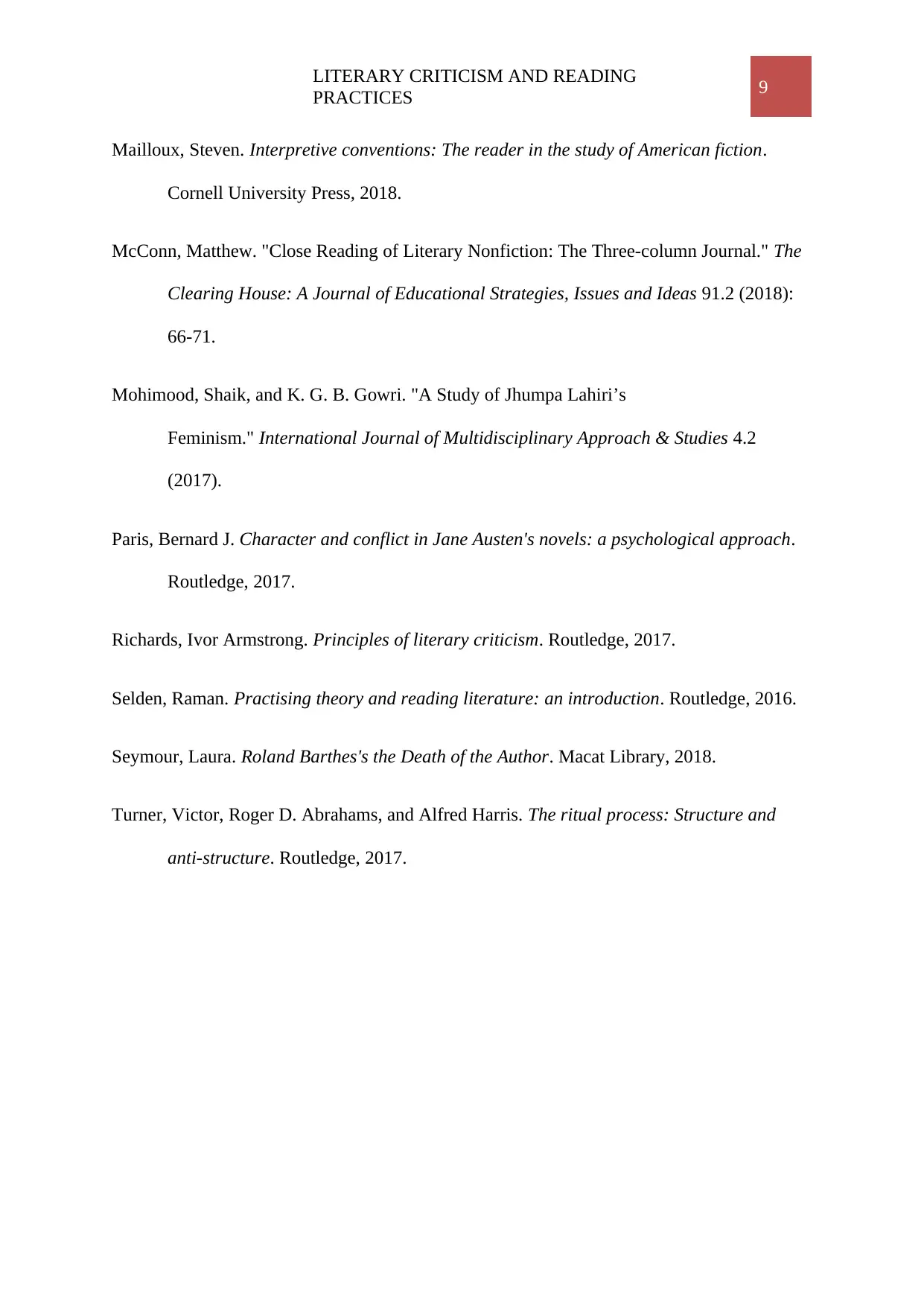
LITERARY CRITICISM AND READING
PRACTICES 9
Mailloux, Steven. Interpretive conventions: The reader in the study of American fiction.
Cornell University Press, 2018.
McConn, Matthew. "Close Reading of Literary Nonfiction: The Three-column Journal." The
Clearing House: A Journal of Educational Strategies, Issues and Ideas 91.2 (2018):
66-71.
Mohimood, Shaik, and K. G. B. Gowri. "A Study of Jhumpa Lahiri’s
Feminism." International Journal of Multidisciplinary Approach & Studies 4.2
(2017).
Paris, Bernard J. Character and conflict in Jane Austen's novels: a psychological approach.
Routledge, 2017.
Richards, Ivor Armstrong. Principles of literary criticism. Routledge, 2017.
Selden, Raman. Practising theory and reading literature: an introduction. Routledge, 2016.
Seymour, Laura. Roland Barthes's the Death of the Author. Macat Library, 2018.
Turner, Victor, Roger D. Abrahams, and Alfred Harris. The ritual process: Structure and
anti-structure. Routledge, 2017.
PRACTICES 9
Mailloux, Steven. Interpretive conventions: The reader in the study of American fiction.
Cornell University Press, 2018.
McConn, Matthew. "Close Reading of Literary Nonfiction: The Three-column Journal." The
Clearing House: A Journal of Educational Strategies, Issues and Ideas 91.2 (2018):
66-71.
Mohimood, Shaik, and K. G. B. Gowri. "A Study of Jhumpa Lahiri’s
Feminism." International Journal of Multidisciplinary Approach & Studies 4.2
(2017).
Paris, Bernard J. Character and conflict in Jane Austen's novels: a psychological approach.
Routledge, 2017.
Richards, Ivor Armstrong. Principles of literary criticism. Routledge, 2017.
Selden, Raman. Practising theory and reading literature: an introduction. Routledge, 2016.
Seymour, Laura. Roland Barthes's the Death of the Author. Macat Library, 2018.
Turner, Victor, Roger D. Abrahams, and Alfred Harris. The ritual process: Structure and
anti-structure. Routledge, 2017.
1 out of 9
Related Documents
Your All-in-One AI-Powered Toolkit for Academic Success.
+13062052269
info@desklib.com
Available 24*7 on WhatsApp / Email
![[object Object]](/_next/static/media/star-bottom.7253800d.svg)
Unlock your academic potential
© 2024 | Zucol Services PVT LTD | All rights reserved.




